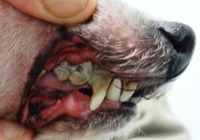5 Quick Tips For Dental Health

Dental disease is far and away the most common problem we see at AVC. What’s more, much of the disease we see is entirely preventable. Below are Dr. Rowland’s top five tips for ensuring your pet’s oral health.
1. No Bones About It
Animal bones, as well as other hard chew toys, are a major cause of broken teeth. This leads to serious pain, sets the tooth up for deep infection, and generally necessitates either extraction (several hundred dollars) or a root canal (even more expensive). Beef bones, antlers, and hard plastic toys like Nyla-Bones are all culprits – keep them away from your dog! Toys made of heavy-duty rubber are a much safer option for satisfying Muffy’s need to chew.
2. Learn To Brush Your Pet’s Teeth
Just like with your own teeth, daily brushing is the best thing you can do to maintain oral health between professional cleanings. If you approach it properly nearly all dogs and cats will tolerate tooth brushing well – and many even seem to enjoy it.
The trick is to approach it as a training task. Make a goal to work with your pet for a few minutes every night, slowly building up to brushing their entire mouth over the course of three or four weeks. Find a flavor of pet toothpaste they like (NO human toothpaste) and start by letting them just lick it off the brush. Then spend a few nights brushing one tooth, or just playing with their lips – whatever they are comfortable with. Stick with it, and as they become more comfortable each day you can work up to brushing their teeth just as thoroughly as your own!
3. Check Out The VOHC List
You’ve surely seen loads of products claiming to help maintain your pet’s dental health – and you’ve probably (rightly) wondered if any of them are effective. While brushing is the gold-standard for home care, there are plenty of special diets, chews and more that can help reduce plaque buildup. The Veterinary Oral Health Council is a group of veterinary dentists that evaluate dental health products for safety and efficacy – check out the list of approved products here. We stock some of our favorites at the clinic, and you can find others at local stores.
4. Watch For Warning Signs
Recognition is the first step in treatment. Here are the most obvious signs of serious oral health problems:
- Bad breath
- Red, swollen gums around teeth
- Eating slower, or with only one side of the mouth
- Facial swelling
- Change in attitude (less playful, less active, more grumpy, etc.)
- But the MOST commonly recognized sign of oral disease is…
- No obvious signs at all
Watching closely for the above signs is really, really valuable. In fact, one of the best things about toothbrushing is it makes you much more observant of what’s going on in your pet’s mouth. However, many of the serious problems we see have no obvious signs to the untrained eye – imagine you had a toothache, but couldn’t communicate it to anyone. How would anyone know? That’s just one more reason why regular checkups with your vet are so important.
5. There Are NO Substitutes For Regular Professional Cleanings, Exams, and X-Rays
Even though you brush your teeth two or three times a day, you still see your dentist for an exam and cleaning at least yearly. Your pets do not have a magic mechanism that keeps their mouth healthier than yours – they need the same care you do!
Maybe even more important is the fact that many problems hide in pet’s mouths and will only be recognized with a thorough exam and dental x-rays under anesthesia. You simply can’t thoroughly examine the mouth of an awake animal, and two-thirds of each tooth is under the gums where it can only be evaluated with an x-ray anyway. Studies have found that x-rays identified important problems in teeth that were normal to the naked eye in over 25% of dogs and 40% of cats. You can’t treat what you don’t look for – and if you don’t treat it, your pet may be living in pain!
